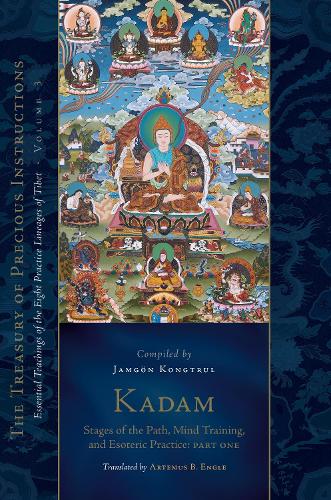
Kadam: Stages of the Path, Mind Training, and Esoteric Practice, Part One: Essential Teachings of the Eight Practice Lineages of Tibet, Volume 3 (The Treasury of Precious Instructions)
(Hardback)
Publishing Details
Kadam: Stages of the Path, Mind Training, and Esoteric Practice, Part One: Essential Teachings of the Eight Practice Lineages of Tibet, Volume 3 (The Treasury of Precious Instructions)
By (Author) Jamgon Kongtrul Lodro Taye
By (author) Artemus B. Engle
Shambhala Publications Inc
Snow Lion Publications
7th May 2024
United States
Classifications
General
Non Fiction
294.3444
Physical Properties
Hardback
1248
Width 152mm, Height 229mm
Description
_x200B_A comprehensive selection of texts central to the Kadam lineage of Tibetan Buddhism, including topics like Mind Training, Stages of the Path, and esoteric tantric instructions. The Treasury of Precious Instructions by Jamg n Kongtrul Lodr Taye, one of Tibet's greatest Buddhist masters, is a shining jewel of Tibetan literature, presenting essential teachings from the entire spectrum of practice lineages that existed in Tibet. In its eighteen volumes, Kongtrul brings together some of the most important texts on key topics of Buddhist thought and practice as well as authoring significant new sections of his own. _x200B__x200B_The Kadam lineage derives from the teachings and practices taught by the Indian master Atisa and his Tibetan students. Atisa spent twelve years in Tibet and left a scholarly and devotional lineage that would be significant to all traditions of Tibetan Buddhism, but particularly the Geluk, the tradition of the Dalai Lamas, which fashioned themselves as the New Kadam tradition. _x200B_ Jamg n Kongtrul's catalog to The Treasury of Precious Instructions classifies Kadam literature into five categories- treatise, instruction, esoteric practice, ancillary works, and associated works. The first two are the main topics covered in this volume- Lamrim, or Stages of the Path, and Lojong, or Mind Training. These two Kadam teachings continue to exert a significant influence on Tibetan Buddhism and therefore represent the legacy of the Kadam tradition. _x200B_The first centers around "The Lamp for the Path to Enlightenment," written by the eleventh-century Indian master Atisa who spent twelve years in Tibet, and this volume also includes stories of Atisa's life and travels. The second set of teachings consists of aphorisms known as the Seven-Point Mind Training, meant to be used as contemplative practices to develop compassion and transform the mind. These selections show not only the foundational texts of the Kadam tradition but also the widespread impact these teachings continued to have across traditions.
Author Bio
JAMG N KONGTRUL LODR TAYE (1813-1900) was a versatile and prolific scholar and one of the most outstanding writers and teachers of his time in Tibet. He was a pivotal figure in eastern Tibet's nonsectarian movement and made major contributions to education, politics, and medicine. ARTEMUS B. ENGLE studied Buddhism with the late Sera Mey Khensur Lobsang Tharchin Rinpoche for more than thirty years. Over much of the past decade, he has continued his studies as a student of Gyume Khensur Lobsang Jampa Rinpoche. In 1983 he earned a doctorate in Buddhist Studies from the University of Wisconsin and is currently a fellow with the Tsadra Foundation.
